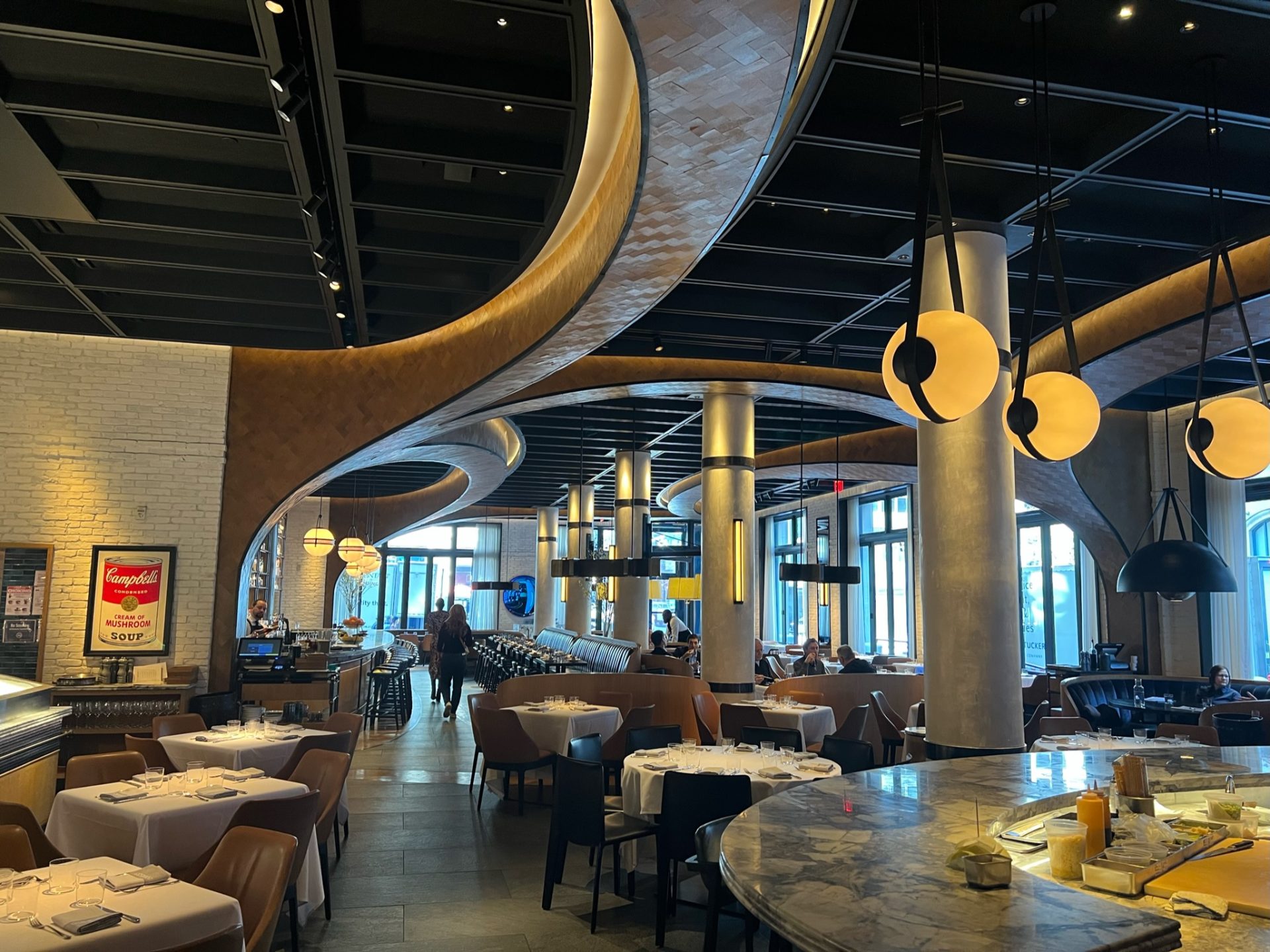Pan Asian Dining Islamabad: Appreciate Genuine Asian Dishes
Pan Asian Dining Islamabad: Appreciate Genuine Asian Dishes
Blog Article
Savor Genuine Asian Cuisine With a Pan-Asian Twist for a Cooking Adventure
Beginning on a cooking trip through genuine Asian food, improved with a Pan-Asian twist, provides a distinct possibility to check out the abundant tapestry of flavors that define the region's varied culinary customs. As you consider these enticing dishes, think about the social stories and historic influences that shape them, each bite offering a story waiting to be uncovered. Best ambiance restaurants Islamabad.

Discovering Pan-Asian Tastes
In the realm of international gastronomy, Pan-Asian food stands apart for its exceptional diversity and the harmonious interplay of flavors from different Asian societies. This culinary approach celebrates the one-of-a-kind ingredients and rich customs discovered throughout the continent, creating a tapestry of tastes that is both fascinating and rewarding. Secret to Pan-Asian food is its ability to stabilize contrasting flavors-- wonderful, salted, spicy, and sour-- while highlighting the freshness and high quality of each active ingredient.
From the umami-rich soy sauce of Japan to the intense chili peppers of Thailand, Pan-Asian food uses a considerable palette of tastes. These elements are typically combined in innovative means, boosting meals with layers of complexity. For circumstances, using aromatic herbs such as lemongrass and cilantro, typical in Vietnamese and Thai cuisine, includes a refreshing brightness to meals, while the consolidation of coconut milk delivers a creamy, abundant texture.
The emphasis on fresh produce and aromatic seasonings guarantees that each meal is not just a banquet for the palate yet likewise for the detects. Pan-Asian food welcomes restaurants to start a culinary journey, discovering the substantial and varied landscapes of Eastern gastronomy with every bite.
Fusion Dishes to Attempt
While Pan-Asian food is commemorated for its standard tastes, the contemporary cooking landscape is progressively accepting fusion recipes that blend these classic components with influences from various other areas. This cutting-edge strategy not only honors the rich heritage of Asian culinary arts yet likewise introduces novel preference experiences that attract contemporary tastes.
An archetype of such a combination recipe is the Korean-Mexican taco, where marinated bulgogi beef is covered in a cozy tortilla, topped with kimchi and a zesty gochujang-infused salsa. This combination weds the bold, savory tastes of Korea with the vibrant, fresh aspects of Mexican food. In a similar way, sushi burritos have gotten popularity, integrating the fragile artistry of Japanese sushi with the passionate, hand-held comfort of a burrito, typically including combination components like tempura shrimp and avocado with a drizzle of wasabi mayo.
One more significant meal is Thai curry ramen, which infuses the velvety, fragrant flavors of Thai curry into the comforting brew of standard Japanese ramen, producing a harmonious mix that entices the detects. These combination dishes expand past simple novelty; they stand for a cooking dialogue between cultures, motivating expedition and advancement worldwide of Pan-Asian food.
Crucial Ingredients and Spices
To really value Pan-Asian cuisine, one have to understand the important ingredients and seasonings that develop its foundation. This diverse culinary design draws from an abundant tapestry of Oriental practices, employing an unified mix of flavors and appearances. Trick active ingredients consist of soy sauce, fish sauce, and oyster sauce, which present a mouthwatering umami deepness important to Asian recipes. Corresponding to these are rice vinegar and mirin, lending a fragile level of acidity and sweetness.
Aromatic elements are pivotal, with ginger, garlic, and lemongrass being common throughout different Pan-Asian recipes. These ingredients offer a great smelling base that improves the complexity of flavors. Seasonings such as celebrity anise, cardamom, and cinnamon introduce heat and personality, echoing influences from regions like China and India.

Food Preparation Strategies and Tips
Grasping the art of Pan-Asian food needs knowledge with its distinct food preparation strategies, each adding to the vivid tapestry of tastes this cooking practice is commemorated for. Central to these techniques is the stir-fry, a rapid cooking method that maintains the dietary stability and vibrant colors of ingredients. Making use of a frying pan, the stir-fry technique permits also heat circulation, necessary for achieving the particular appearance and taste equilibrium of Pan-Asian meals.
Another basic strategy is steaming, especially widespread in Chinese food. This mild approach preserves the natural tastes and nutrients of ingredients, making it suitable for seafood and veggies. Dumplings, a cherished staple, often take advantage of steaming, leading to soft, succulent structures.
Barbecuing, also integral, imparts smoky midsts to recipes such as Korean bulgogi or Japanese yakitori (asian restaurant isb). This strategy commonly involves marinating active ingredients, enabling tastes to permeate deeply before food preparation over an open flame or warmer
Lastly, grasping the art of stabilizing tastes-- wonderful, sour, salty, bitter, and umami-- is vital. Appropriately layering these aspects can boost a meal from ordinary to extraordinary, offering a facility and pleasing cooking experience that embodies the significance of Pan-Asian food.
Eating Experiences Worldwide
Across the globe, Pan-Asian food supplies an exceptional dining experience, celebrated for its rich tapestry of tastes and vibrant discussions. This cooking sensation has gone beyond social boundaries, recording the hearts and tastes buds of food enthusiasts worldwide. In cosmopolitan cities like New York, London, and Sydney, Pan-Asian dining establishments serve as melting pots where culinary traditions from Thailand, Japan, China, and past converge, giving restaurants with a diverse mix of recipes that highlight the area's variety.
The global appeal of Pan-Asian cuisine hinges on its capacity to supply both authenticity and innovation. Cooks skillfully wed typical ingredients see here such as lemongrass, soy sauce, and miso with modern methods, resulting in recipes that are both familiar and refreshingly new. This blend enables diners to begin on a cooking trip that values heritage while welcoming modernity.
Moreover, eating experiences are raised via attentively designed environments that mirror the principles of Pan-Asian aesthetic appeals. From minimalist Japanese-inspired interiors to vivid Thai-themed spaces, each dining establishment offers a distinct setting that enhances the culinary offerings. As an outcome, customers are not just eating a dish however partaking in a social experience, making Pan-Asian eating an absolutely global sensation.
Verdict
The exploration of Pan-Asian cuisine supplies an extensive understanding of the complex interaction of tastes and culinary customs across Asia. By embracing combination meals such as Thai curry ramen and sushi burritos, the culinary trip not just highlights the flexibility of typical ingredients however likewise showcases cutting-edge modern-day techniques. This gastronomic adventure, enhanced by cooking techniques and necessary spices, offers a distinct chance to appreciate the multiculturalism and culinary creativity that define Pan-Asian food on an international scale.
Beginning on a cooking journey with authentic Eastern food, boosted with a Pan-Asian twist, supplies a special possibility to explore the abundant tapestry of flavors that specify the region's diverse cooking traditions.In the realm of international gastronomy, Pan-Asian food stands out for its exceptional variety and the harmonious interplay of tastes from numerous Asian cultures. Key to Pan-Asian cuisine is its ability to stabilize contrasting flavors-- sweet, peking house salted, spicy, and sour-- while highlighting the quality and high quality of each component.

Report this page